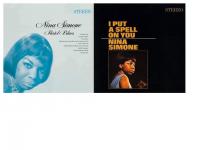Nina Simone’s Enduring Artistry Evident on Two Verve/Acoustic Sounds Series Philips Reissues
Nina Simone (born Eunice Kathleen Waymon) released her first album in 1959 on Syd Nathan’s Bethlehem Records label (Nathan is best known for King Records, James Brown’s original label). Analogue Productions released an all-analog stereo edition of Little Girl Blue and now in partnership with Verve/UMe has released two of those Philips era albums cut by Ryan Smith using the original tapes.
The Little Girl Blue review hyper-linked above contains a great deal of Simone background information but if you're unfamiliar with the remarkable Nina Simone please watch the Netflix feature documentary, "What Happened, Miss Simone?" — which won the 2016 Emmy for Outstanding Documentary. Her life story is filled with both tragedy and triumph and it helps explain why Simone’s artistry endures and continues to engage generations of music lovers, decades after she passed away in 2003 at age 70.
Whether you have an original pressing or especially if you bought the aforementioned box set (or either of these albums from the box that were later available individually), within a few seconds of the opening percussive cracks on Pastel Blues made by hand claps and a hi-hat on “Be My Husband” (written by Andrew Stroud— Simone’s husband at the time and a former policeman who eventually turned abusive) you’ll know you’re hearing a vastly superior edition of the album, both aurally and emotionally. The all analog version's superior three-dimensionality, transparency and attention to the small details produce a "you are there" sensation the digitized versions hide behind a scrim. The originals were never well-mastered or pressed.
Backed by a group that included musicians who toured with Simone, she runs through a well-chosen set that is, as the liner notes suggest “about the blues” more than it’s an album of blues, though it’s a damn bluesy outing. Simone had a minor hit with the Depression-era chestnut “Nobody Knows You When You’re Down and Out” but what stands out the most here is her rendering of “Strange Fruit”, immortalized by Billie Holiday.
Categorizing or pigeonholing Simone’s talents is impossible, either as a singer or as a pianist. She was classically trained and added singing only after racism thwarted her concert hall aspirations. “Ain’t No Use”, which opens side two is the purest “blues” on the album, but Simone’s piano fluidity takes the song beyond the basics, while her vocal is raw and direct. Her devastating Strange Fruit serves as the set’s denouement, which is followed by an extended “Sinnerman”— a worthwhile, show stopping encore (though of course this is a studio session that Simone treats like a live performance) that Simone delivers with power usually reserved for the stage. What sounds like a mediocre recording on the digitized version comes to transparent and three-dimensional life on this edition. The laminated gatefold presentation completes the package.
I Put a Spell On You, which was an earlier release, with its strings and sophisticated brassy arrangements by Hal Mooney and the legendary Horace Ott (who’s still with us) plays more like a studio album than does Pastel Blues. Both Mooney and Ott had remarkably diverse careers as musicians, arrangers and composers. Ott co-wrote “Don’t Let Me Be Misunderstood” included on Simone’s Philips album Broadway-Blues-Ballads (PHS 600-148) later a hit for The Animals. Ott also arranged Simone’s version of Dimitri Tiomkins’ “Wild is the Wind”, most rockers know from David Bowie’s cover. Mooney’s arranging career includes associations with Frank Sinatra, Bing Crosby, Peggy Lee, Sarah Vaughan and many others.
The A&R choices here are as eclectic as you’d hope for on a Nina Simone album including of course the title track. Simone covers songs by Anthony Newley and Leslie Bricusse from their Broadway show “The Roar of the Greasepaint” and “Marriage is For Old Folks” from the musical “The Secret Life of Walter Mitty”, as well as a few titles flown in from France including Jacques Brel’s “Ne Me Quitte Pas” and pairs by Charles Aznavour and Simone’s husband Andrew Stroud—one being a 40’s style Louis Jordan-ish “in praise of sex” (as Simone claims in the notes) “Gimme Some”.
I Put a Spell On You is a thoughtful, often joyful sophisticated set of well-chosen, popular songs (pop of that era is unlike today’s pop) that Nina Simone delivers with unerring charm and warmth. It’s her most consistently excellent Philips era album and it and Pastel Blues, both released in 1965, are ideal showcases for both Simone’s enduring artistry and for what made her Philips era records special. The sound of both of these records is the best that’s been produced from these tapes and both records are well worth owning.


